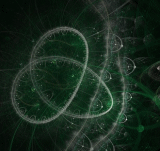
String theory
Overview
String theory is an active research framework
in particle physics
that attempts to reconcile quantum mechanics
and general relativity
. It is a contender for a theory of everything
(TOE), a manner of describing the known fundamental force
s and matter
in a mathematically complete system. The theory has yet to make novel experimental predictions at accessible energy scales, leading some scientists to claim that it cannot be considered a part of science
.
String theory mainly posits that the electron
s and quark
s within an atom
are not 0-dimensional objects, but rather 1-dimensional oscillating lines ("strings").
Conceptual framework
A conceptual framework is used in research to outline possible courses of action or to present a preferred approach to an idea or thought. For example, the philosopher Isaiah Berlin used the "hedgehogs" versus "foxes" approach; a "hedgehog" might approach the world in terms of a single organizing...
in particle physics
Particle physics
Particle physics is a branch of physics that studies the existence and interactions of particles that are the constituents of what is usually referred to as matter or radiation. In current understanding, particles are excitations of quantum fields and interact following their dynamics...
that attempts to reconcile quantum mechanics
Quantum mechanics
Quantum mechanics, also known as quantum physics or quantum theory, is a branch of physics providing a mathematical description of much of the dual particle-like and wave-like behavior and interactions of energy and matter. It departs from classical mechanics primarily at the atomic and subatomic...
and general relativity
General relativity
General relativity or the general theory of relativity is the geometric theory of gravitation published by Albert Einstein in 1916. It is the current description of gravitation in modern physics...
. It is a contender for a theory of everything
Theory of everything
A theory of everything is a putative theory of theoretical physics that fully explains and links together all known physical phenomena, and predicts the outcome of any experiment that could be carried out in principle....
(TOE), a manner of describing the known fundamental force
Fundamental interaction
In particle physics, fundamental interactions are the ways that elementary particles interact with one another...
s and matter
Matter
Matter is a general term for the substance of which all physical objects consist. Typically, matter includes atoms and other particles which have mass. A common way of defining matter is as anything that has mass and occupies volume...
in a mathematically complete system. The theory has yet to make novel experimental predictions at accessible energy scales, leading some scientists to claim that it cannot be considered a part of science
Science
Science is a systematic enterprise that builds and organizes knowledge in the form of testable explanations and predictions about the universe...
.
String theory mainly posits that the electron
Electron
The electron is a subatomic particle with a negative elementary electric charge. It has no known components or substructure; in other words, it is generally thought to be an elementary particle. An electron has a mass that is approximately 1/1836 that of the proton...
s and quark
Quark
A quark is an elementary particle and a fundamental constituent of matter. Quarks combine to form composite particles called hadrons, the most stable of which are protons and neutrons, the components of atomic nuclei. Due to a phenomenon known as color confinement, quarks are never directly...
s within an atom
Atom
The atom is a basic unit of matter that consists of a dense central nucleus surrounded by a cloud of negatively charged electrons. The atomic nucleus contains a mix of positively charged protons and electrically neutral neutrons...
are not 0-dimensional objects, but rather 1-dimensional oscillating lines ("strings").
Unanswered Questions

